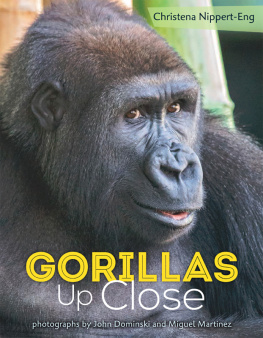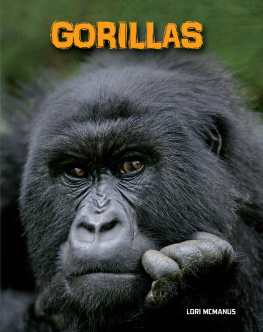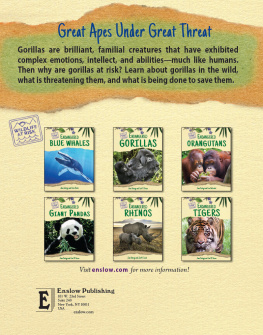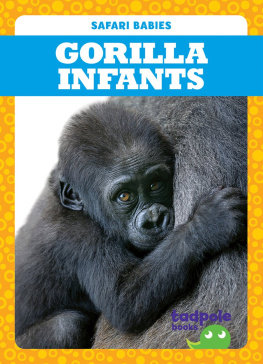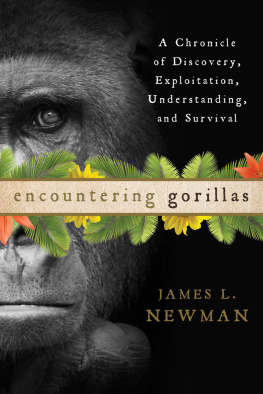GORILLAS Up Close

Christena Nippert-Eng
with John Dominski, Frederick Grier, Jim Hornor,
Eugene Limb, Sally Limb, and Miguel Martinez
Henry Holt and Company
New York
The author and publisher have provided this e-book to you for your personal use only. You may not make this e-book publicly available in any way. Copyright infringement is against the law. If you believe the copy of this e-book you are reading infringes on the authors copyright, please notify the publisher at: http://us.macmillanusa.com/piracy.

This book is dedicated to
Madie and Jonah Doppelt,
Bella and Lukie Gratzl,
Jock and Joyce Hornor,
Barb Murdoch and Craig Dominski,
Tena, Vic, and Victor C. Nippert,
Gilda Schutt and Ana Lilia Torres,
and the memory of Pat Hart and Andy Henderson.
The gorillas featured in this book were photographed in their habitats as they went about their daily routines. We used only natural lighting to get the images.


Gorillas. Whats not to love? Theyre smart, fun, busy, and hairyfrom the incredibly cute to the seriously scary. Theyre knuckle walkers. Vegetarian, too. Who knew you could become that strong just by eating your veggies?
Scientific evidence shows that about ten million years ago, gorillas and humans had a common ancestor. That ancestor would eventually produce one branch of the family made up of gorillas and another branch of the family made up of chimpanzees, bonobos, and humans. Gorillas are not humans, but we are both great apes. Somewhere deep in our brains, we share some of the same sensibilities.
Who knew you could become that strong just by eating your veggies?
There are approximately 350 gorillas living in North American zoos.

We both love our families and would do anything for them. We get seriously annoyed with them sometimes, too. We take care of our infants and raise our kids in astonishingly similar ways. Leadership, teamwork, and the quest for status are extremely important to both of us. What we say to one another with our eyes and bodies can be even more important than what we vocalize. We both come in different shapes, sizes, and colors, possessing a remarkable range of personalities. Both humans and gorillas have unique fingerprints, but gorillas also have unique nose prints. We share many of the same illnesses, from asthma to heart disease. We get up in the mornings, work and play during the day, and, if we have a choice, go to sleep in a comfy bed at night. We also both love good foodand will travel quite a ways for a special meal.

Individual gorillas have unique fingerprints and nose prints.

Today, gorillas who live in zoos can provide unique opportunities for us to discover how much we have in common with them. There are approximately 350 gorillas living in North American zoos that are accredited, or approved, by the Association of Zoos and Aquariums. In this book, youll read about some of these gorillas and how they spend their days, especially a gorilla named Kwan and his family.
Zoos in the United States first started exhibiting gorillas around 1930. As with other species, people were fascinated by zoo gorillas, but they didnt understand their needs. It is another story for the gorillas living in todays accredited zoos. These institutions now play a vital role in furthering our understanding of and respect for these great apes. Armed with decades of experience and an ever-growing body of fascinating research, accredited zoos in the United States and Canada follow important, agreed-upon welfare standards for the optimal care of their gorillas. These zoos work continually to improve and share their best practices with one another. They are committed to providing the fullest, healthiest life possible for all gorillas. Zoo experts work closely with the staff of gorilla sanctuaries as well as with people trying to save gorillas in the wild, where the future of these great apes looks uncertain at best.

There is still much to learn about gorillas. They are currently at the center of a number of important debates. How intelligent, emotional, and self-aware are they? What does this mean for how we should treat them? How can we best protect gorillasphysically, economically, and legallyincluding those who live in the wild, in sanctuaries, and in zoos? What should be the role of zoo gorillas in ensuring the future of the species? Anytime we take on the responsibility of caring for another individual, there are going to be significant challenges involved and difficult decisions to be made. When it comes to gorillas, new research, ethical concerns, and threats to their survival in the wild mean that these conversations have never been more important.

What should be the role of zoo gorillas in ensuring the future of the species?
Most of us will not get to spend time with gorillas in the wild or in sanctuaries. At the zoo, however, curious visitors can get to know these great apes up close and learn about gorillas both as a species and as individuals. Each gorilla has a remarkable past and is full of personality, emotion, and surprises. Watching zoo gorillas closely and quietly can help us all begin to realize how much we have in common with these distant cousins of ours.
Lets start by getting to know Kwan. Hes an adult male gorilla who lives with his family of six females in the city of Chicago, Illinois, located in the midwestern part of the United States.
We take care of our infants and raise our kids in astonishingly similar ways.
KWAN
(KWAHN )

Kwan walks quadrupedallyon all four limbs.
Theres no doubt about it: Kwan is one impressive guy. Hes a silverback, which is an adult male gorilla. He lives at Lincoln Park Zoo in Chicago. Kwan is the leader of his troop and a dad who takes his job very seriously.

